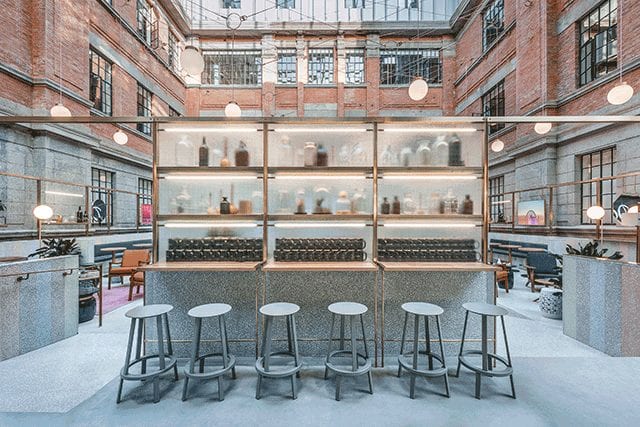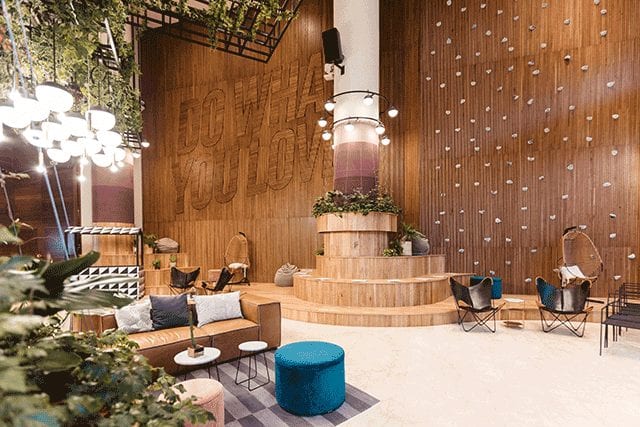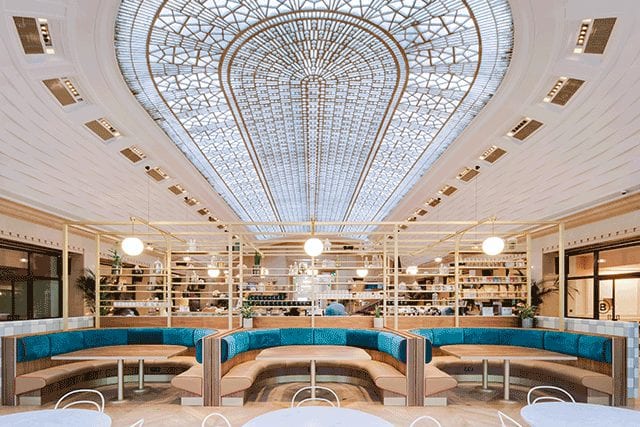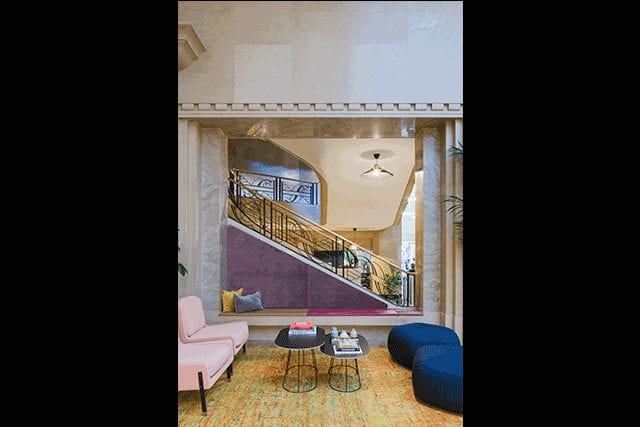Brittney Hart wanted to be a doctor, but after taking an interior design course in college, “I threw myself fully into the discipline,” she says. “I never looked back after that.” She cut her teeth working at for LA’s Greg Lynn Form and ShoP Architects and Peter Marino Architect in New York, and in 2012 opened her own practice with her husband, Justin, aptly called Husband Wife. They were both recruited to work at WeWork two years ago.
Since her time at the company, which now boasts nearly 163 coworking spaces in 52 cities worldwide, Hart has been integral in crafting member-driven experiences in spaces that are as functional as they are beautiful. “From the programming to artwork to design elements and down to every detail, each project is an exciting challenge,” she says. Along with expanding in existing communities like London, Los Angeles, and Shanghai, WeWork is opening up in new markets including Toronto, Vancouver, Nashville, Rio de Janeiro, Bogotá, and Melbourne. Here, Hart talks about building relationship with local designers, the symbiotic relationship between hospitality and coworking, and reimagining work-life balance.
Before WeWork, what job or project do you consider your big break?
At Husband Wife, we developed a very close relationship with Roll & Hill, a lighting company based in New York. They asked that we assist with the design of their pavilion for Salone del Mobile several years ago. It is the first time I can recall creating something that showcased our own design language. They were a client willing to take some risks. The space was extremely well-received, and our relationship with Roll & Hill flourished. They later asked us to design their first showroom, a three-story space in SoHo.
When WeWork approached you and your husband to join the team, what drew you about the coworking powerhouse?
WeWork is as a platform for creators, and when you walk into one in any city, you immediately understand what that means. There’s a palpable energy that’s unlike any workspace I’ve ever experienced. How and why people work is changing. A lot of people are not interested in clocking-in and clocking-out, they’re interested on working on projects they’re passionate about in an energetic environment where others are also working hard to bring their ideas to life. We’re seeing a shift where individuals, small companies, and even larger corporations see the benefits in being a part of a community that’s focused on working to make a life, not just a living.
As someone who started a design firm, I also identified with WeWork members. When I toured my first WeWork, I realized that we would be designing spaces for individuals and small businesses in a similar position when Justin and I started Husband Wife. We understood the difficulties around starting your own business. We were really drawn to WeWork’s mission to set companies up for success.
What role does hospitality play in your current role at WeWork?
Hospitality is at the forefront of my day-to-day. We are designing for a wide range of member types that come into our spaces with a specific purpose and goal. When I am looking at the design of our spaces, I am always considering how members use our spaces, what their experience is like when they walk through the front door, and how to create special moments that feel welcoming. We ultimately strive to create spaces that operate as a home for a member’s business.
Can you tell us what you’re currently working on?
This year alone, WeWork has expanded to Detroit, Beijing, and more recently Buenos Aires, Sao Paulo, and Paris. WeWork Torre Bellini in Buenos Aires has a really impressive voluminous lobby space. There is custom millwork throughout the lobby, native Brazilian plants hanging above to bring the outside in, and a fully functional rock-climbing wall. Our members in WeWork La Fayette enjoy a beautiful 22-foot atrium for workspace where the ceilings are made of its original glass blocks. It has amazing natural light and a great Art Deco vibe that I just love.
Is there a project that you’re most looking forward to?
We’ve just opened a new location in Bengaluru, India called WeWork Galaxy. It’s our first India location, and our design team spent a few weeks in Bengaluru to pull design inspiration for a space that was originally built for a shopping center. It’s also the first of any WeWork to feature a rooftop pool for our members. There’s a fairly large atrium space on the ground floor that is perfect for activation with tons of seating, and areas to gather and hold events. We’re having fun with color blocking as a way to delineate moments within a larger space like this one. When you have a five-to-six story atrium, it’s difficult to create a space that feels intimate without breaking it up. It’s been fun to doing something visually appealing that fosters all sorts of interaction and it will be something our design team will experiment more with in upcoming locations.
WeWork has a reputation of working with emerging local designers, why is that important to the company?
[We are] a global company with a local playbook. It’s important for our internal design teams to collaborate with local designers to ensure the pieces, the colors, the intent behind each design feature or element works with the architectural elements—not against it. By choosing firms that are emerging designers with a like-minded approach, the goal is that we can help each other grow in ways that are far more exciting and impactful for each design project.
What are some of your biggest lessons learned?
It is extremely important for designers to be flexible and to understand that things change quickly. You may spend several months designing a space that suddenly requires redesign due to an unexpected shift. Designers can’t hold on too tight and should know that an opportunity, just as exciting, is right around the corner.

Designed in collaboration with Linehouse, WeWork Weihai Lu in Shanghai is anchored by a triple-height atrium.
What are some of the challenges you’ve had to overcome as a designer?
I don’t think there is anything more challenging than starting your own business. As someone who isn’t super comfortable with the unknown, taking the leap and hoping that you will achieve success is extremely scary. It’s what brought me to WeWork—knowing that we would be touching the lives of so many people who are exploring the unknown was too exciting an opportunity to pass up.






